Personalized Customer Experience: 6 Powerful Ways for Success 2025
The Evolution of Customer Expectations
A personalized customer experience is so much more than a marketing buzzword—it’s the art of making each customer feel truly seen and valued. Think of it as crafting a unique journey for every person who interacts with your brand, using their individual preferences and behaviors to create moments that feel tailor-made just for them.
“There’s only one thing that will make your customers want to come back to you more than the amazing customer experience. It’s an amazing personalized customer experience.” – Shep Hyken
What is a personalized customer experience?
When we talk about creating a personalized customer experience, we’re really talking about five essential elements working together in harmony:
First, it’s data-driven, using the breadcrumbs of information customers willingly share with us. It’s also contextual, ensuring that your message arrives at just the right moment in their journey. True personalization is omnichannel, maintaining a consistent feel whether customers are browsing your website, using your app, or walking into your physical store. It stays relevant by aligning perfectly with individual needs and preferences. And finally, it’s adaptive, evolving as your relationship with each customer grows and changes.
Remember when being greeted by name in an email felt special? Those days are long gone. Today’s savvy consumers expect brands to understand their unique needs and anticipate their next move. The numbers tell the story—80% of customers are more likely to buy from brands that personalize their experience, and a striking 71% now expect personalized interactions as the standard, not the exception.
This shift isn’t just good for customers—it’s fantastic for business. Companies that excel at personalization see revenue increases of 5-15%, conversion rates jumping by 10-15%, and marketing costs dropping by 10-20%. But perhaps most valuable of all, they build the kind of loyalty that turns customers into passionate advocates.
I’ve seen how the right personalization strategy can transform businesses. As Samir ElKamouny AV, I’ve helped companies of all sizes create meaningful connections that convert casual browsers into loyal buyers. My approach blends data-driven insights with human-centered design, creating experiences that feel both intelligent and genuinely warm.
The journey mapping process has become essential as brands steer this new landscape, carefully plotting each touchpoint to ensure relevance. With the explosion of customer data available, successful companies are finding ways to create value while maintaining careful consent management. The rise of omnichannel engagement and AI-powered personalization is opening exciting new possibilities for brands ready to accept them.
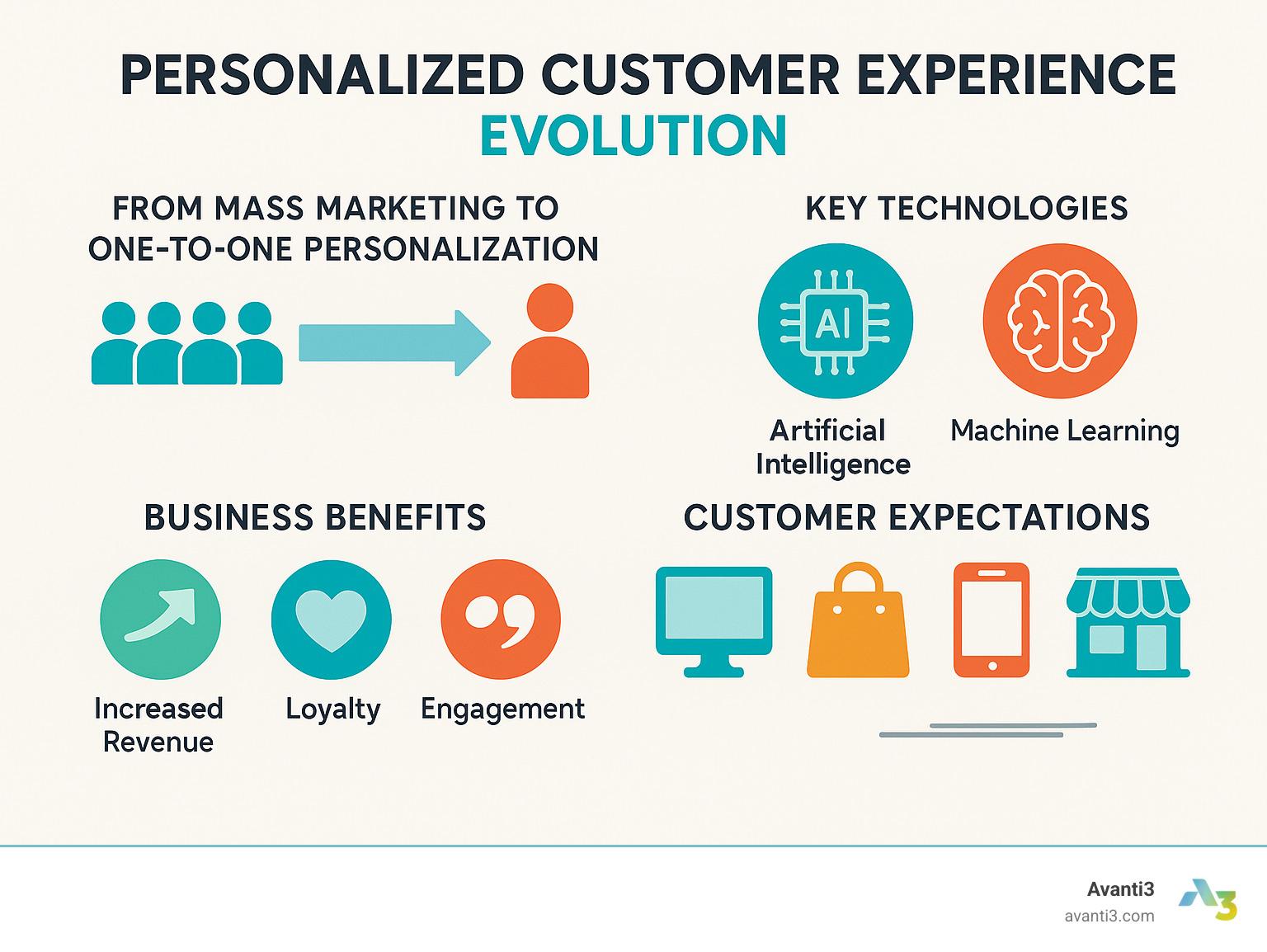
1. Harness First-Party Data Goldmine
In today’s digital landscape, your customer data isn’t just valuable—it’s essential gold for creating a truly personalized customer experience. As third-party cookies fade into the sunset, first-party data (the information customers share directly with you) has become the crown jewel for brands who want to connect meaningfully with their audience.
The numbers tell a compelling story: McKinsey found that companies experiencing faster growth generate 40% more revenue from personalization than their slower-growing competitors. What sets these leaders apart? Their ability to thoughtfully collect, seamlessly unify, and strategically activate customer data.
The Data Foundation
Building a solid foundation for personalization isn’t complicated, but it does require intention and care. Think of it as creating a detailed portrait of each customer that becomes clearer with every interaction.
Your Customer Data Platform (CDP) serves as the central nervous system—collecting signals from every touchpoint and creating that elusive “single customer view” marketers dream about. When you add thoughtful behavioral tracking, you gain insights into how customers actually engage with your digital properties, not just what they say they want.
The real magic happens when you combine this with zero-party data—information customers willingly share through quizzes, preference centers, and feedback. This approach feels less like surveillance and more like a conversation.
As Amazon founder Jeff Bezos wisely noted: “Put the customer first. Invent. And be patient.” This philosophy perfectly captures how we should approach data collection—focus on creating value, find innovative ways to learn about your customers, and understand that building rich profiles happens over time, not overnight.
Real-World Success: The Digital Twin Approach
Forward-thinking brands have acceptd “digital twins” of their customers—comprehensive virtual profiles that bring together every interaction, preference, and behavior. This approach delivers personalization with remarkable precision.
One global apparel brand that implemented this technology saw their business transform:
– Average order values jumped 35%
– Conversion rates improved by a stunning 46.7%
– Customer lifetime value increased by 25%
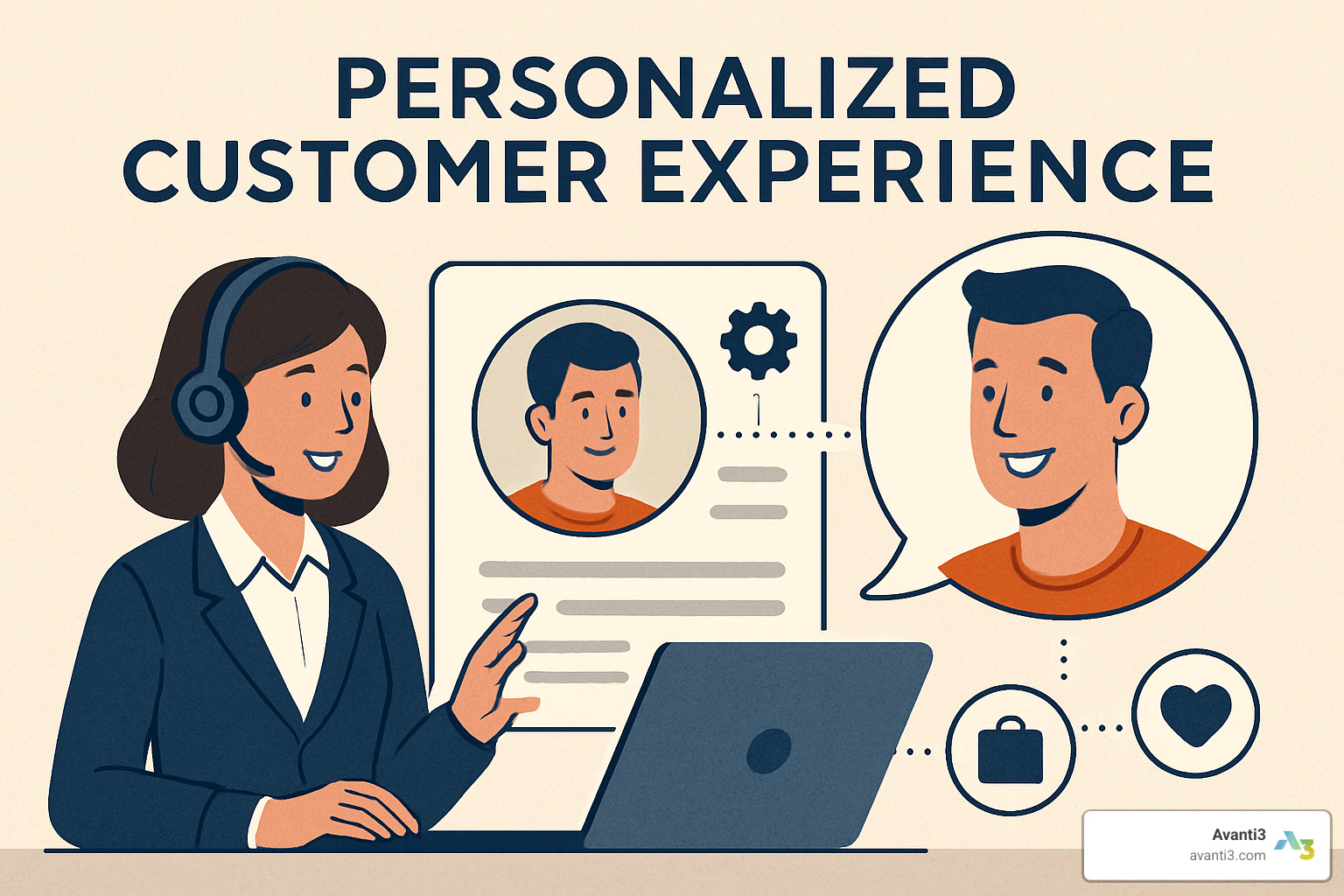
Balancing privacy with a personalized customer experience
With great data comes great responsibility. Today’s consumers are increasingly savvy about how their information is used, and regulations like GDPR and CCPA have raised the stakes considerably.
Finding the sweet spot between privacy and personalization isn’t about legal compliance alone—it’s about building trust through transparency and creating a fair value exchange. When customers understand what they’re getting in return for sharing their data, they’re far more willing to participate.
Interestingly, 83% of consumers say they’ll share personal information to enable personalization when they trust the brand and see clear benefits. This reveals what experts call the “privacy paradox”—while people express concerns about data privacy, their actual behavior shows they’ll share information when they understand what’s in it for them.
At Avanti3, we’ve developed consent frameworks that don’t just meet legal requirements—they actually build stronger customer relationships by giving people visibility and control over their information. We believe privacy should improve the customer experience, not limit it.
The most successful brands treat data collection as a gradual getting-to-know-you process rather than an interrogation. Through progressive profiling, you can build comprehensive customer understanding over time, gathering only what’s relevant at each stage of the relationship.
71% of consumers expect personalization according to McKinsey research, but they also expect you to be responsible stewards of their information. When you strike this balance correctly, you create both business value and customer goodwill—a true win-win.
For more insights on how to leverage personalized data effectively, check out our guide on Personalized Data: How It Drives Engagement.
2. Segment & Micro-Segment Like a Pro
Remember when putting customers into basic age and location buckets was enough? Those days are long gone! Today’s personalized customer experience requires a much more nuanced approach to truly understand who your customers are and what makes them tick.
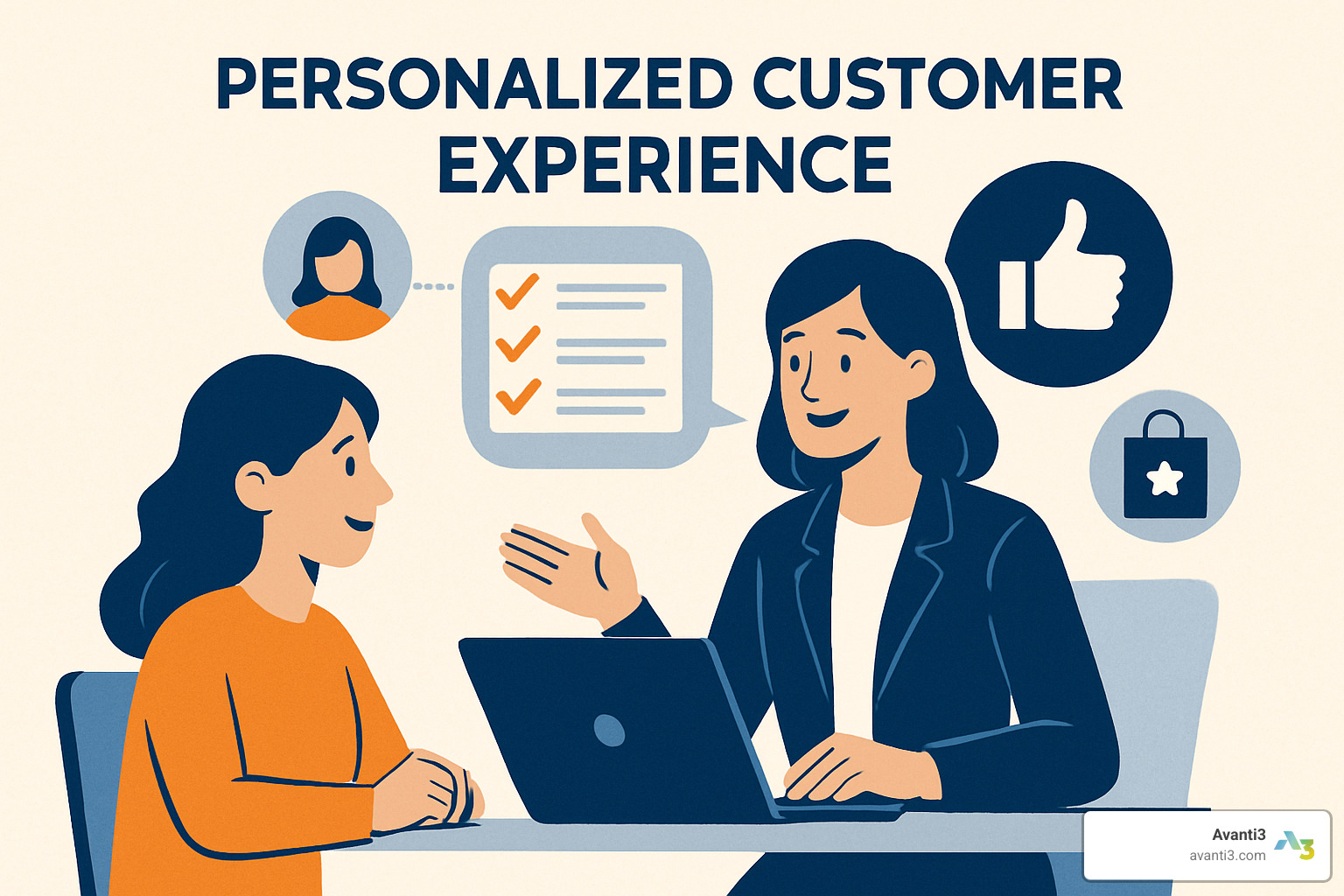
Beyond Basic Demographics
Think of your customers as complex, fascinating individuals (because they are!). When we work with brands at Avanti3, we help them see beyond simple categories by exploring multiple dimensions of customer identity.
What are your customers actually doing on your site? Their behavioral patterns tell a rich story about their interests and needs. One click might reveal more than a dozen demographic data points ever could.
We also love diving into psychographic factors – the values, attitudes and lifestyle choices that drive decisions. A 35-year-old suburban parent might share identical demographics with thousands of others, but their unique beliefs and interests make them respond to completely different messaging.
I remember working with a retail client who was struggling with generic marketing campaigns. When we shifted from their 5 broad customer groups to over 20 detailed micro-segments based on how people actually shopped, their email engagement jumped by a remarkable 72%! Their conversion rates climbed 35% because we were finally speaking to customers as individuals.
Understanding where someone stands in their relationship with your brand (lifecycle segmentation) also transforms how you communicate. You wouldn’t talk to a first-time visitor the same way you’d chat with a loyal customer of three years, right?
From broad segments to one-to-one personalized customer experience
The holy grail of personalization is treating each customer as a segment of one – and thanks to AI and machine learning, this dream is now reality.
At Avanti3, our Digital Engagement Solutions help brands create these individualized experiences through some pretty amazing technology. AI-driven clustering identifies patterns in your customer data that even the most talented human analyst might miss. We can assign predictive scores to help you understand which customers are most likely to purchase – or unfortunately, to leave.
What’s really exciting is how we can update these segments in real-time. Your customer isn’t frozen in time, and neither should their profile be! As they browse, buy, and engage, their segment updates automatically to ensure they always receive the most relevant experience.
Netflix exemplifies this approach beautifully. As their tech team explains, “We don’t have one product but over 100 million different products with one for each of our members with personalized recommendations and personalized visuals.” That level of individualization is why they remain an industry leader despite fierce competition.
I saw this magic happen with a luxury retailer client. After implementing our micro-segmentation approach, they saw their average order value increase by 17%, customer retention improve by 12%, and engagement with personalized content jump to three times higher than before.
The insight that made all the difference? When customers genuinely feel understood – when they sense you’re speaking directly to their unique needs and preferences – they don’t just engage more. They buy more, stay longer, and often become your most passionate advocates.
3. Delivering a Personalized Customer Experience Through Predictive Recommendations
Remember the joy of a shopkeeper who knows exactly what you need before you ask? That’s what today’s AI recommendation engines bring to the digital world. These clever systems have become the heart of effective personalized customer experience strategies, quietly analyzing mountains of data to anticipate customer desires with remarkable accuracy.
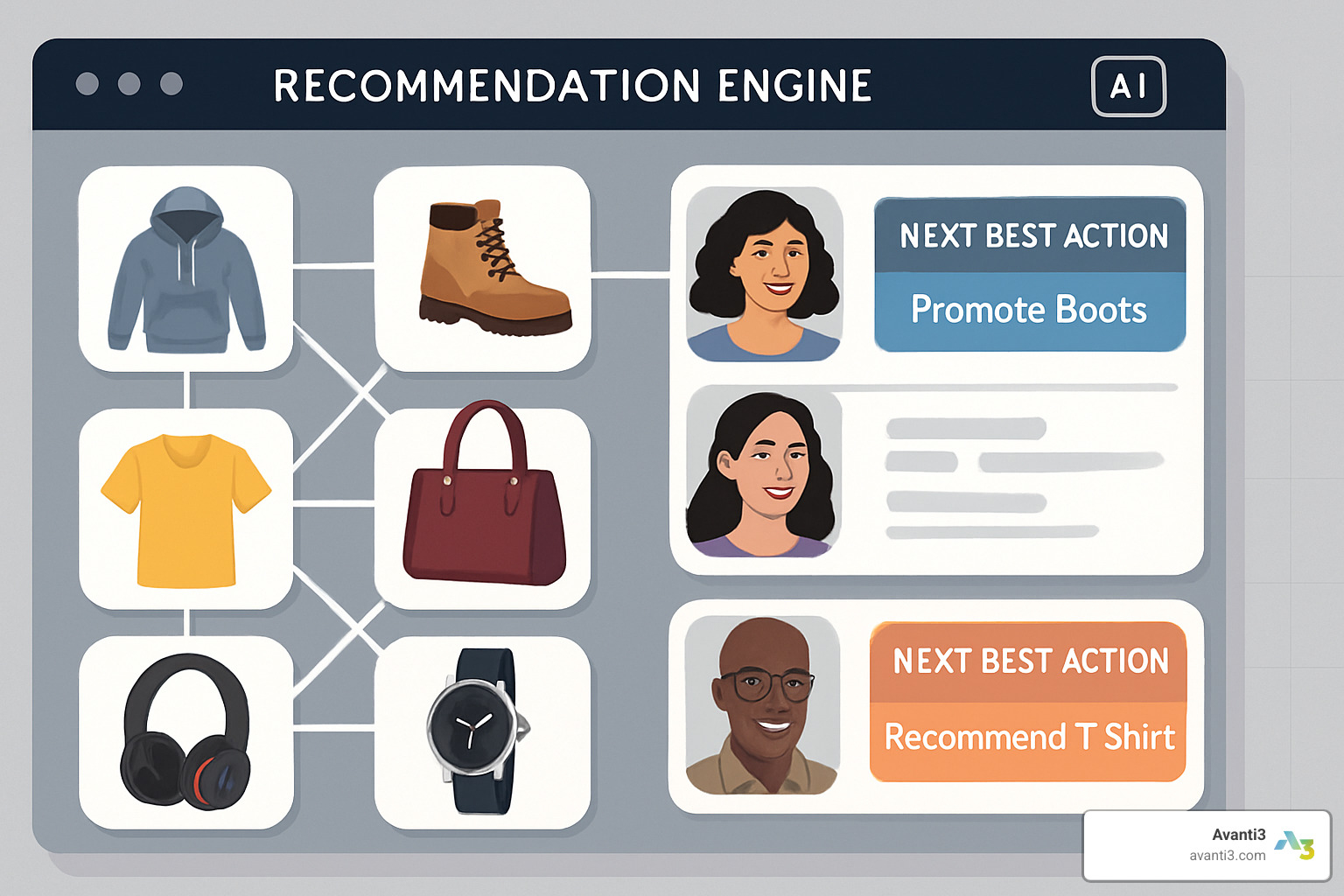
The Science Behind the Magic
Behind every “you might also like” suggestion is sophisticated technology working to understand you better. Modern recommendation engines employ several approaches to get this right.
They might use collaborative filtering (the digital equivalent of “people like you enjoyed this”), or content-based filtering that connects you with items similar to your past favorites. Many systems employ hybrid approaches that blend multiple techniques for better accuracy, while others consider contextual factors like the time of day or your location.
What makes these systems truly remarkable is how they evolve. Like good friends who learn your preferences over time, recommendation engines get smarter with every interaction. According to Venturebeat research, this value is widely recognized—92% of businesses now use AI-driven personalization to improve customer experiences.
The results speak for themselves. One of our ecommerce clients implemented our recommendation engine and watched their average order value jump by 35%, while conversions increased by 24% and cart abandonment dropped by 15%. Those aren’t just numbers—they represent thousands of customers finding exactly what they needed.
Beyond Product Recommendations
While “customers who bought this also bought that” might be the most familiar form of AI recommendations, these systems can personalize far more aspects of your customer experience.
Smart brands use them to suggest relevant content like articles or videos that match customer interests. They can determine the optimal next step in each customer’s unique journey. Some even offer personalized pricing through special bundles or discounts, or adapt website layouts to individual preferences for a truly customized experience.
I worked with a financial services company that implemented this approach for their customer service team. Their system would quietly suggest the most relevant offers based on each customer’s profile and the context of the conversation. The human touch remained, but now it was informed by AI insights. The result? Cross-sell success rates increased by 47%, and customers were happier with the more relevant service.
How AI powers personalized customer experience at scale
Creating individual experiences for millions of customers would be impossible without AI’s helping hand. The technology makes mass personalization feel intimate through several key capabilities:
Neural networks can spot complex patterns in behavior that even experienced marketers might miss. Deep learning systems continuously improve their understanding as they process more interactions. Natural language processing helps decode customer intent from conversations, while computer vision recognizes visual preferences and patterns.
According to scientific research on AI impact, companies effectively using AI for personalization can achieve up to 15% revenue growth. But the same research reveals an important truth: consumer confidence in AI personalization remains divided. This highlights why transparent, value-driven implementation matters so much.
At Avanti3, our AI Digital Marketing solutions balance cutting-edge algorithms with human warmth. We believe AI should improve human judgment, not replace it.
One of our retail clients used this balanced approach to create “complete the look” suggestions that felt like they came from a personal stylist rather than an algorithm. By analyzing browsing behavior, seasonal trends, and inventory alongside purchase history, the system offered genuinely helpful recommendations. Customers responded by adding 27% more items per order and expressing significantly higher satisfaction.
The most effective personalization doesn’t feel algorithmic—it feels thoughtful. Like a gift from someone who truly knows you.
4. Orchestrate Omnichannel Moments That Matter
Today’s customers don’t think in channels—they expect a seamless personalized customer experience whether they’re browsing your website, scrolling through your mobile app, walking into your physical store, or chatting with customer service. Creating harmony across these touchpoints isn’t just nice to have—it’s essential for brands that want to truly connect with their audiences.
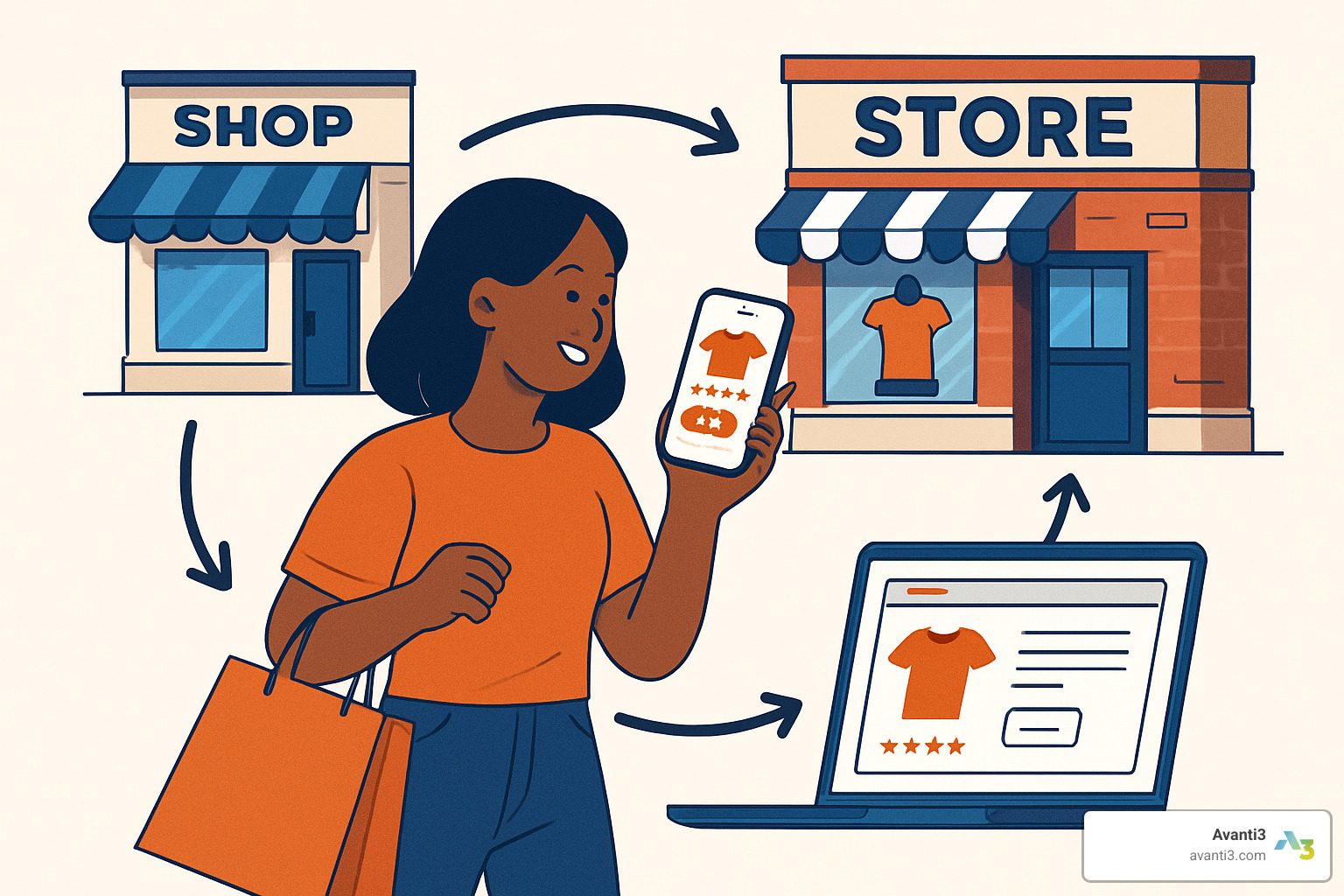
The Omnichannel Imperative
Did you know that customers who engage with brands across multiple channels spend 4-10 times more than those who stick to just one? It’s true! Yet many companies still struggle to deliver consistent, personalized experiences as customers hop between touchpoints.
What makes omnichannel personalization work? It starts with understanding channel preferences—knowing whether a customer prefers email for promotions but text messages for shipping updates. Then there’s send-time optimization, delivering messages when your customer is most likely to see and engage with them.
We helped a boutique hotel chain transform their guest experience by recognizing visitors across their website, mobile app, email communications, and in-person interactions. When a guest researched spa services online but didn’t book, they’d receive a thoughtful mobile notification with a special offer upon check-in. This simple but effective approach boosted their ancillary service bookings by 31% and made guests feel genuinely understood.
Cross-channel journey mapping reveals how customers naturally move between touchpoints to accomplish their goals. By visualizing these paths, you can identify friction points and opportunities for delight. And of course, consistent personalization rules ensure that recommendations and offers remain relevant no matter where a customer encounters your brand.
Innovative Omnichannel Techniques
Forward-thinking brands are creating magic with new approaches to omnichannel experiences. AR/VR try-ons let customers virtually sample products before purchasing—imagine seeing how that new sofa would look in your actual living room! Location-based personalization delivers timely offers when customers are near your physical locations, bridging the digital-physical divide.
Sephora exemplifies this innovative spirit. Their mobile app lets customers virtually try makeup products, save their favorite looks to their profile, and receive custom recommendations both online and from in-store beauty advisors. This seamless integration has helped them build remarkable loyalty, with 80% of transactions coming from members of their personalized rewards program.
Other powerful techniques include real-time inventory integration that shows customers products available at their preferred store location, and cross-device persistence that maintains shopping carts and preferences as customers switch from laptop to phone to tablet.
Seamless handoffs sustain a personalized customer experience
Nothing frustrates customers more than having to repeat themselves or restart their journey when switching channels. “I just told your website all this information—why am I explaining it again on the phone?” Sound familiar?
Creating smooth transitions between channels requires several key elements. Unified customer identity means recognizing the same person across all touchpoints. Persistent shopping carts remember items and preferences across sessions and devices. Conversation history gives service agents visibility into previous interactions, and channel-specific optimization adapts content for each platform while maintaining a consistent message.
We worked with a telecommunications provider to implement a unified customer view that gave their service representatives complete visibility into all previous interactions—whether they happened on the website, mobile app, or previous calls. This approach cut average handle time by 23% and significantly boosted satisfaction scores by eliminating repetitive conversations.
At Avanti3, we specialize in blending traditional channels with emerging technologies like blockchain, NFTs, and AR/VR to create truly seamless experiences. We believe the future of omnichannel is increasingly immersive and interactive—combining physical and digital touchpoints to create memorable moments that strengthen customer relationships.
The best part? When you orchestrate these moments well, customers don’t even notice the technology—they simply enjoy a natural, friction-free experience with your brand that keeps them coming back for more.
5. Empower Frontline Teams with Contextual Intelligence
While technology drives much of modern personalization, the human element remains critical—especially for high-value or complex interactions. Empowering customer-facing teams with the right information at the right time is essential for delivering a truly exceptional personalized customer experience.
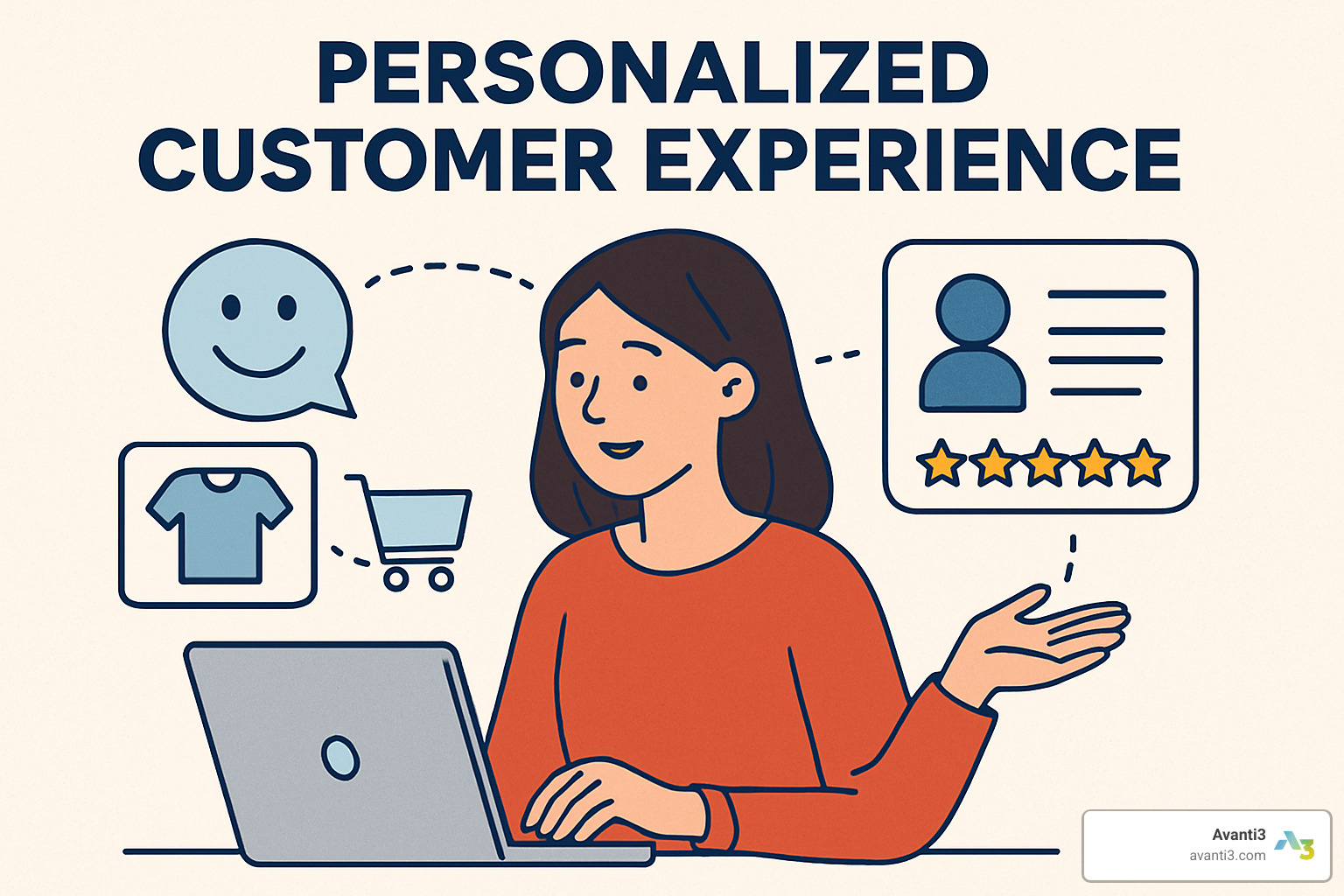
The Human Touch in a Digital World
Despite our love affair with technology, the truth is that 82% of consumers still crave human interaction in their customer experiences. It’s like getting a text versus a hug – sometimes there’s just no substitute for the real thing.
The challenge many brands face isn’t whether to include the human element, but how to equip their frontline employees with the insights they need to deliver personalized service at scale. Think of it as giving your team superpowers – they’re still the heroes, but now they can see through walls (of data).
Effective frontline empowerment starts with 360° customer profiles that give staff a complete view of each person’s history and preferences. Imagine walking into your favorite coffee shop and the barista not only remembers your name but also knows you’ve been traveling, asks about your trip, and suggests your usual order – that’s the feeling we’re aiming for, even in digital interactions.
A financial services company we partnered with implemented a system providing advisors with real-time customer insights during conversations. Their system highlighted important life events (like a recent home purchase), suggested relevant products, and even recommended conversation topics based on customer interests. The results spoke volumes – customer satisfaction jumped by 24% while cross-sell rates improved by 17%.
Balancing Automation and Human Expertise
The sweet spot in personalization isn’t choosing between automation and human touch – it’s finding the perfect blend of both.
AI-assisted service can handle routine inquiries while routing complex issues to human agents who bring empathy and creative problem-solving to the table. It’s like having a really efficient assistant who handles the paperwork so you can focus on the meaningful conversations.
Mojo Coffee exemplifies this balanced approach brilliantly. As barista Christian Cook explains: “What makes Mojo different from other coffee shops is it’s got the resources of a large company, but definitely with the heart of a small company. We ask you how your day is going and we remember your name and what you like to drink, how you like to drink it.”
This combination of efficiency and personal connection creates those memorable moments that turn customers into loyal fans. The technology remembers the details, but the human delivers the smile.
Emotional intelligence training helps teams recognize and respond appropriately to customer emotions – whether that’s frustration, excitement, or confusion. When combined with augmented intelligence tools that provide real-time guidance, staff can respond with both heart and helpful information.
Turning insights into humanized personalized customer experience
The magic happens when data transforms into meaningful human connections. It’s not just about knowing a customer’s purchase history – it’s about understanding the story behind it.
Emotion detection systems can identify customer sentiment from voice, text, and behavior patterns, giving staff valuable context before they even begin a conversation. But the real differentiator is contextual awareness – understanding not just what the customer has done, but what they’re trying to accomplish right now.
One surprisingly effective personalization tactic we’ve implemented is strategic forgiveness. A retail bank we worked with created a “forgiveness” system allowing staff to waive fees or make exceptions based on customer history and value. This approach didn’t just make customers happy – it increased retention of high-value customers by 14%. Sometimes the most meaningful personalization is simply showing that you value the relationship more than the rule book.
At Avanti3, we firmly believe that technology should improve human capabilities, not replace them. Our solutions handle the heavy lifting of data analysis and routine tasks through automation, freeing your team to focus on creating those meaningful moments that build emotional connections.
The future of personalized customer experience will be defined by this delicate balance – using cutting-edge technology to manage scale and complexity while preserving the uniquely human elements that create emotional connections and lasting loyalty. After all, people don’t fall in love with algorithms – they connect with brands that make them feel seen, understood, and valued.
6. Measure, Test, and Iterate Continuously
Creating an effective personalized customer experience isn’t something you set up once and forget. It’s more like tending a garden—requiring ongoing care, attention, and refinement to truly flourish. The most successful companies accept this reality by making measurement and testing central to their personalization strategy.
The Measurement Framework
Think of your personalization metrics as different instruments in an orchestra—each plays a crucial role in creating the full symphony of understanding. A well-rounded measurement approach combines immediate signals with long-term indicators:
| Metric Type | Examples | Purpose |
|---|---|---|
| Engagement Metrics | Click-through rates, time on site, pages per visit | Measure immediate interaction |
| Conversion Metrics | Purchase rate, form completions, sign-ups | Track goal completion |
| Customer Value Metrics | Average order value, purchase frequency, lifetime value | Assess economic impact |
| Experience Metrics | Net Promoter Score (NPS), Customer Satisfaction (CSAT), Customer Effort Score (CES) | Gauge customer perception |
| Operational Metrics | Response time, first-contact resolution, cost per interaction | Evaluate efficiency |
I worked with a financial services company that took an interesting approach to this challenge. Rather than looking at metrics in isolation, they created what they called a “personalization value index”—essentially a weighted score that combined various metrics based on how strongly each one predicted long-term customer value. This holistic view helped them focus on initiatives that drove sustainable growth rather than just chasing short-term wins.
The Testing Imperative
When it comes to personalization, assumptions are often the enemy of success. What seems logical might not resonate with your actual customers, and what works brilliantly for one segment might fall flat with another. That’s why testing isn’t just important—it’s essential.
Successful personalization programs accept a test-and-learn culture where experimentation is celebrated, not feared. This means running regular A/B tests comparing different personalization approaches, maintaining control groups to accurately measure impact, and continuously challenging current best practices with new ideas.
One e-commerce client I worked with made testing the cornerstone of their recommendation engine strategy. Instead of settling for “good enough,” they systematically tested different algorithms, placements, and messaging approaches. The results spoke for themselves: a 47% improvement in recommendation click-through rates and 23% higher conversion rates in just six months.
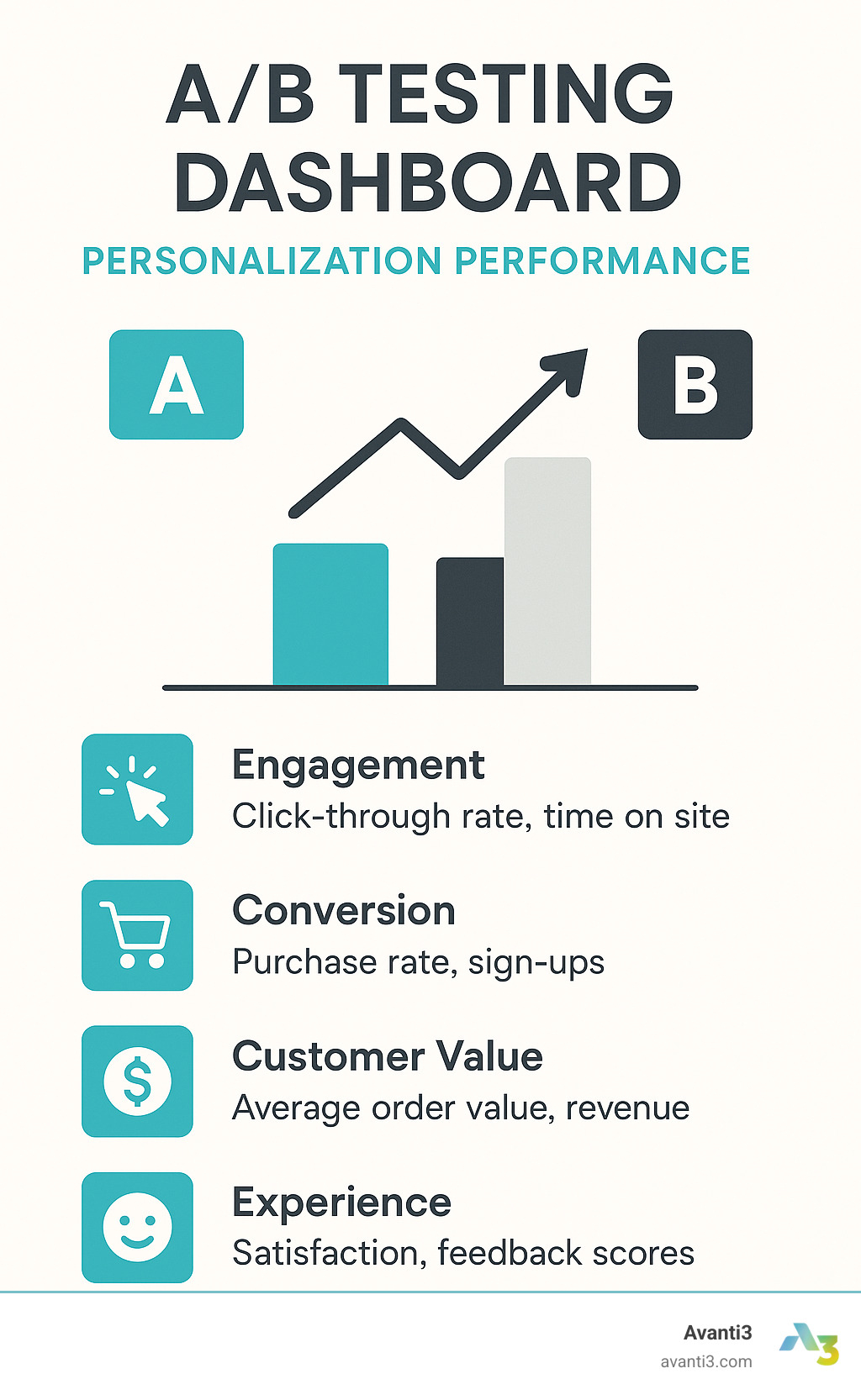
Agile Personalization
The most effective personalization programs borrow principles from agile software development—and for good reason. The agile approach emphasizes rapid iteration, cross-functional collaboration, and regular reflection, all of which are perfectly suited to personalization work.
By organizing personalization initiatives into short, focused sprints, you can implement changes quickly, gather data on their impact, and make adjustments before moving on. Cross-functional teams bringing together marketing, IT, data science, and customer service ensure that all perspectives are considered. And regular retrospectives help teams learn from both successes and failures.
As McKinsey aptly notes, this approach requires “a significant shift in the mindsets of employees so that they become comfortable with the experiments personalization requires.” But the payoff is worth it: organizations that accept agile personalization can respond much more quickly to changing customer needs and market conditions.
At Avanti3, our Personalized Data solutions help organizations build these capabilities from the ground up. We believe deeply in data-driven decision-making, but we also know that numbers alone aren’t enough—they must be balanced with creative thinking and genuine customer empathy.
One retail client used our platform to implement what they called a “test factory” approach. Rather than making occasional big bets, they systematically tested different personalization tactics across their entire customer journey—from homepage personalization to abandoned cart messaging to post-purchase follow-ups. This methodical approach helped them identify the highest-impact opportunities and achieve a 15% increase in overall conversion rates.
The key insight I’ve gained from working with dozens of companies on personalization initiatives is simple but profound: Personalization is never “done.” The most successful organizations view it as a continuous journey of learning and improvement, constantly refining their approach based on what their customers tell them—both through explicit feedback and through their behavior. When you accept this mindset, personalization becomes not just a marketing tactic but a powerful engine for ongoing business growth.
Frequently Asked Questions about Personalized Customer Experience
What technologies do I need to start?
You don’t need to invest in a complex tech stack to begin creating a personalized customer experience. Many businesses start their personalization journey with just a few fundamental tools:
A good Customer Data Platform (CDP) or CRM system forms the backbone of your personalization efforts by centralizing all your customer information in one place. Pair this with basic analytics tools to understand how customers interact with your brand across touchpoints.
Most companies already have an email marketing platform—just make sure yours offers basic personalization features like name insertion and segmentation. Add a simple website personalization tool that can display dynamic content, and you’ve got everything you need to get started.
“We began our personalization journey with just our existing CRM and email platform,” shared one of our retail clients. “Within three months, we saw a 12% increase in email engagement just by implementing basic behavioral triggers.”
As your strategy matures and shows results, you can gradually add more sophisticated technologies like AI recommendation engines, journey orchestration platforms, and real-time decisioning systems. The key is starting with tools that address your most pressing opportunities, then expanding as you demonstrate success.
Remember Jeff Bezos’s advice: “Put the customer first. Invent. And be patient.” Personalization is a journey, not a destination.
How do I avoid the “creepy” factor?
The line between helpful personalization and feeling like you’re being watched is thin and constantly shifting. What feels convenient to one customer might feel invasive to another.
Transparency is your best defense against the “creepy factor.” Be upfront about what data you’re collecting and how you’re using it to improve the customer experience. When customers understand the value exchange—what they get in return for sharing their information—they’re much more likely to welcome personalization.
One bank we worked with added simple explanations next to personalized offers: “We’re suggesting this savings account because you recently increased your monthly deposits.” This transparency increased offer acceptance by 23%.
Always give customers control over their data and personalization preferences. This might be as simple as preference centers that let them choose what types of communications they receive or as sophisticated as granular privacy settings.
Context matters tremendously. A recommendation based on past purchases feels helpful, while one based on something a customer believes was a private conversation feels invasive. Before implementing any personalization tactic, ask yourself: “Would I be comfortable if a brand did this to me?”
Which metrics prove success fastest?
When building the business case for personalization, you need a mix of quick wins and long-term value metrics to demonstrate both immediate impact and sustainable growth.
In the short term, focus on engagement metrics that respond quickly to personalization efforts. Click-through rates on personalized content typically improve within days of implementation. Conversion rate improvements, reductions in cart abandonment, and increases in email engagement also show results relatively quickly.
“We saw our email open rates jump by 15% within the first two weeks of implementing personalized subject lines and send times,” reported a financial services client. “That early win helped us secure budget for more advanced personalization initiatives.”
As your program matures, track medium-term metrics like increases in average order value, purchase frequency, and customer satisfaction scores. These typically take a few months to show meaningful patterns.
For long-term value, nothing beats customer lifetime value as the north star metric for personalization. Retention improvements, increased share of wallet, and positive trends in Net Promoter Score all indicate that your personalization efforts are building lasting customer relationships.
At Avanti3, we help clients develop balanced measurement frameworks that capture both immediate impact and long-term value creation. We often identify “lighthouse metrics”—specific measurements that clearly demonstrate personalization value in your unique context. For an e-commerce company, this might be conversion lift from personalized recommendations. For a subscription business, it might be reduced churn from personalized engagement programs.
The right metrics not only prove success but also guide your ongoing personalization strategy, ensuring you’re creating experiences that truly resonate with your customers while driving business growth.
Conclusion
The journey to delivering exceptional personalized customer experience is never truly complete. It’s a path that evolves as technology advances and customer expectations shift. Throughout this article, we’ve seen how creating meaningful personalization requires bringing together data, technology, processes, and people in harmony.
When I reflect on what makes personalization truly effective, several key insights stand out:
First and foremost, data is the foundation of everything we do. Without unified, high-quality customer information, personalization efforts will always fall short. The most successful brands are building robust first-party data strategies while carefully navigating privacy concerns and respecting customer consent. This balance isn’t always easy, but it’s absolutely essential.
Segmentation enables relevance in ways that transform customer interactions. Moving beyond simple demographics to understand behaviors, needs, and customer value creates opportunities for much more meaningful connections. I’ve seen how brands that evolve from basic segmentation toward treating each customer as a unique individual consistently outperform their competitors.
The scale of modern business would make personalization impossible without technology. AI powers scale by allowing brands to deliver individualized experiences to millions of customers simultaneously. The magic happens when we accept these powerful tools while maintaining a distinctly human touch in our approach.
Today’s customers rarely think in terms of channels – they simply expect your brand to recognize and remember them regardless of how they connect. Omnichannel creates seamlessness that customers increasingly demand, requiring both sophisticated technology integration and thoughtful organizational alignment to execute well.
While technology enables personalization at scale, humans provide the emotional connection that technology alone cannot replicate. The brands that balance automation with genuine human empathy and creativity – especially during high-value interactions – create the most memorable customer experiences.
Finally, the most successful personalization strategies accept constant improvement. Measurement drives improvement through a test-and-learn culture backed by robust analytics. The brands that consistently outperform competitors are those willing to experiment, learn from failures, and continuously refine their approach.
At Avanti3, we’re pushing the boundaries of what personalization can be by integrating Web3 technologies like NFTs, blockchain, AR/VR, and AI into comprehensive engagement solutions. Our approach helps brands create unique digital experiences, innovative reward systems, and community-building opportunities that take personalization to entirely new levels.
The future of personalization is increasingly immersive and interactive, blurring traditional boundaries between physical and digital worlds. Imagine AR/VR experiences for virtual product try-ons, NFTs that transform loyalty programs into exclusive membership communities, and blockchain systems that make rewards completely transparent and transferable. These technologies aren’t just futuristic concepts – they’re creating unprecedented engagement and loyalty for forward-thinking brands today.
As you start on your own personalization journey, implementing technology isn’t the end goal – creating meaningful customer connections that drive business value is what truly matters. Start with clear objectives, celebrate quick wins while building toward your long-term vision, and always keep your customer at the center of every decision.
To explore how Avanti3 can help transform your customer experience through advanced personalization technologies, visit our AI Customer Engagement page.
The personalization revolution is really just beginning. The brands that will thrive in this new era are those that skillfully combine data-driven insights with human creativity to create experiences that resonate with customers as individuals, not data points. The question isn’t whether personalization matters – it’s whether your brand will lead or follow as this revolution unfolds.







